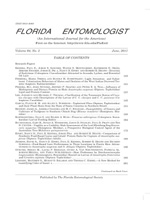Although many different insects can be found in rice fields in Florida, stink bugs are currently considered the most important pest. Jones & Cherry (1986) reported that the rice stink bug, Oebalus pugnax (R), was the dominant species comprising >95% of the total stink bug population. Cherry et al. (1998) reported that the stink bug, Oebalus ypsilongriseus (DeGeer) was widespread in Florida rice fields. This was the first report of this species being found in commercial rice fields in the United States. Cherry and Nuessly (2010) reported that the stink bug, Oebalus insularis (Stal) is now wide-spread in Florida rice fields. This was the first report of this species being found in commercial rice fields in the United States.
Two other stink bug species which attack Florida rice are Euschistus ictericus (L.) and the southern green stink bug, Nezara viridula (L.) (Genung et al. 1979). Previous to this study, these 5 stink bug species were all observed by the author in light trap samples taken at the Everglades Research and Education Center, Palm Beach County, Florida. This center is located near the center of the rice producing area in southern Florida. The center itself consists of a mosaic of rice, sugarcane, vegetable, turf, and biofuel plots. Nothing is known on the seasonal flight of these 5 rice pests in southern Florida. Hence, the objective of this study was to determine the seasonal flight activity of these 5 stink bug species which attack Florida rice.
Flight activity of stink bugs was measured with a large, walk-in black light trap. This trap measured 2 m × 2 m × 2.5 m high and was made of wood with screened sides. On the top was a 15 watt black light with a funnel through which insects fell into the trap below. The trap was located on the Everglades Research and Education Center at Belle Glade, Florida in an area composed of mixed vegetation (various crops, grasses, weeds, trees). The trap was used twice weekly at 3-4-d intervals from Jan 1, 2008 to Jan 1, 2010. After collection by vacuuming, stink bugs were frozen for later taxonomic identification and sex determination. Samples from within each month for both years were pooled. Thereafter a Least Significant Difference Test (SAS 2010) was conducted to compare mean monthly catches for each stink bug species. Fifty adults of each species were randomly selected from samples and dissected to determine sex ratios. These ratios were tested by Chi-square analysis for each species to determine if the ratios were significantly different from an expected 1 to 1 sex ratio.
TABLE 1
RICE STINK BUGS CAUGHT1 IN A BLACKLIGHT TRAP TWICE WEEKLY FROM 1 JAN 2008 THROUGH 1 JAN 2010.

Adults of both sexes were caught in light trap samples in all 5 species. Chi-square analysis showed that there was no significant deviation from the expected 1 to 1 sex ratio in any of the 5 species. The largest Chi-square value found was 1.62 among the species, this not being significant at alpha = 0.05 (1 df).
Monthly catches of stink bugs in the black light are shown in Table 1. Flight activity of all 5 species was remarkably in synchrony, being unimodal with greatest catches in Jul in all species. Reasons for this flight activity are not known. It is difficult to associate this flight activity with a particular food source. Any association is prevented by the polyphagous feeding habits of the stink bugs which result in a broad range of host plants. Numerous crops such as rice, sorghum, wheat, barley, oats, rye, corn, and soybean (McPherson & McPherson 2000) and numerous weeds (Cherry & Bennett 2005) are known to be hosts for 1 or more of the 5 stink bug species. However, it should be noted that this flight activity is in synchrony with the time of greatest rice heading (grain filling) in Florida. This heading occurs during Jul and Aug in the main crop (first crop) of rice and all 5 species attack rice near or at rice heading (Genung et al. 1979; McPherson & McPherson 2000). Although there is rice heading later in the 1 ratoon crop in Florida, not all growers keep their rice in production to grow this crop and heading in ratoon rice is more variable within the crop itself.
Timing of planting date has shown positive results in keeping stink bugs away from crops at their most vulnerable time (McPherson & McPherson 2000). Litsinger (1994) gives examples of planting dates being used to reduce insect damage of numerous rice pests including stink bugs. Our data suggest that planting date could be used to move rice heading from this period of greatest flight activity, thus reducing stink bug populations in the rice. However, moving rice planting dates may pose other problems for rice growers. Planting rice too early may result in frost damage, and rice in Florida may alternate with other crops such as corn and sugarcane grown at different times on the same land. Hence, rice planting and harvesting are frequently timed in conjunction with these other crops. Our data suggest that planting date may be used to avoid stink bug damage in rice, but movement of planting date is also contingent upon other grower considerations. Last, thanks are given to Dr. Joe Eger for help in taxonomy.
SUMMARY
A 2-year light trap study was conducted to determine the seasonal flight activity of 5 species of stink bugs which attack Florida rice. Flight activity of all 5 species was remarkably in synchrony, being unimodal with greatest catches in Jul in all the species. These data suggest that planting date can be used to reduce stink bug damage in Florida rice.





